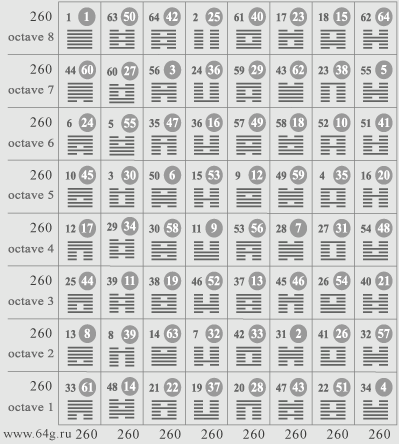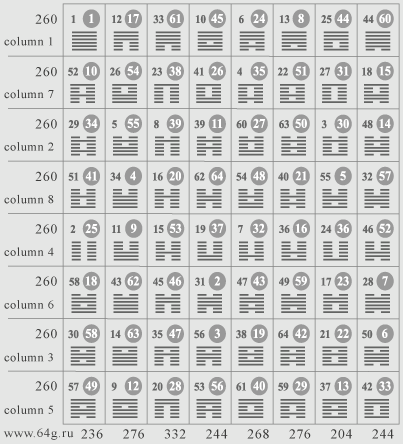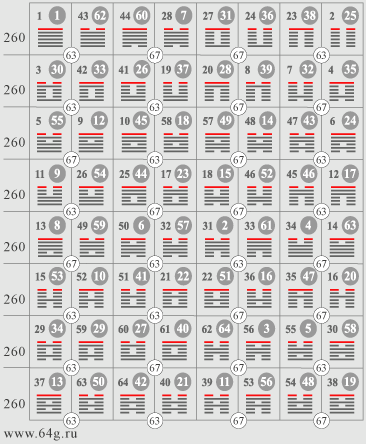-
In addition to chronological solar cycle and Chinese cyclic calendar of zodiacal
animals it is possible to correlate hexagrams of the Book of Changes i-ching to
28 sectors of lunar zodiac or 28 days of four moon phases, and also with ciphers
of dominoes and 56 mantic cards in minor Arcana of predictive Tarot. Because
eight hexagrams can symbolize geographic directions or spatial coordinates of
world space. And 64-8=56 hexagrams can be correlated to minor Arcana of
predictive Tarot deck, or 56/2=28 ciphers of dominoes and sectors of lunar
zodiac which was known in astrology of ancient China and India alongside with
twelve solar zodiacal signs.
For this purpose sixty four hexagrams of the Book of Changes can be arranged in
eight-digit groups or octaves which are shown in the table.
 |
Each horizontal row of the table is one octave in which
eight symbols or digits of hexagrams i-ching are grouped. Each octave unites hexagrams which have symmetric geometrical ratios or otherwise to tell interrelations in five spheres which form structure of the Chinese cyclic calendar of zodiacal animals, that is shown on the previous page. 2nd octave. 7-8 and 13-14 between 1 and 2 spheres. 31-32 and 41-42 between 4 and 5 spheres. 7th octave. 55-56 and 59-60 between 1 and 2 spheres. 23-24 and 43-44 between 4 and 5 spheres. 3rd octave. 37-38 and 39-40 between 1 and 4 spheres. 25-26 and 45-46 between 2 and 5 spheres. 6th octave. 51-52 and 57-58 between 1 and 4 spheres. 5-6 and 35-36 between 2 and 5 spheres. 4th octave. 27-28 and 53-54 on 2 sphere. 11-12 and 29-30 on 4 sphere. 1st octave. 19-20 and 33-34 also 21-22 and 47-48 between 1 and 5 spheres. 5th octave. 3-4 and 49-50 also 9-10 and 15-16 on 3 sphere. 8th octave. 17-18 and 61-62 on 3 sphere, also four hexagrams 1-2 and 63-64 which arrange a cross. Interconnected hexagrams in five spheres and eight octaves form pairs and quadras which look on pages of this website in section which is named as circles of emotions. Dark figures in the table specify serial numbers, and numerical values of hexagrams i-ching are shown by white figures in dark circles. |
-
Numerical values in each octave and also in each vertical column of the shown
table have mathematical sum 260, that forms magic square.
Besides numerical values on the central diagonals and in each quarter of the
shown table have mathematical sum 260, that too forms magic square.
Top three lines or trigrams in hexagrams of each octave do not repeat, and in
each column are identical.
Bottom trigrams in all octaves and columns of the shown table do not repeat.
The shown table forms mathematical or magic matrix of eight octaves according to
which it is possible to correlate hexagrams of the Chinese Book of Changes i-ching
with 56 mantic cards in minor Arcana of predictive Tarot and 28 celestial
sectors of lunar zodiac.
The shown magic matrix of eight octaves is similar to the Silk Text of Mawangdui
quadratic arrangement of sixty four hexagrams, but differs a little, that is
shown on the following table.
 |
Horizontals of the table in Mawangdui quadratic
arrangement correspond to verticals in the magic matrix of eight
octaves. Namely hexagrams on horizontals of Mawangdui quadratic
arrangement correspond to vertical columns of magic matrix of eight octaves. For example, hexagrams with serial numbers 1, 44, 6, 10, 12, 25, 13, 33 on the first left column of magic matrix of eight octaves and on the first top horizontal of Mawangdui quadratic arrangement are identical. Top trigrams in hexagrams on each horizontal of Mawangdui quadratic arrangement are identical, and on each vertical do not repeat. Bottom trigrams on all verticals and horizontals do not repeat, that is similar to the magic matrix of eight octaves. But numerical values of hexagrams on verticals of Mawangdui quadratic arrangement do not form magic sum or number 260 as on the matrix of eight octaves, that is shown under the table. Though pay attention that numbers 276 and 244 form mathematical sum 520 which is equivalent to number 260, as 276+244=520/2=260. |
Mawangdui quadratic arrangement of sixty four hexagrams has been written in Silk
Texts which are discovered by Chinese archaeologists near Changsha of Hunan
province in China on 1972 in tombs of 2 century B.C.
Contemporary archaeologists and scientific researchers of culture and philosophy
of ancient China cannot explain applicability and esoteric sense of Mawangdui
quadratic arrangement, but I hope that the shown tables will help to discover an explanation.
The Book or Classic of Changes i-ching or zhouyi has comments or Appendices
which are named as Ten Wings. These comments or Appendices have information that
sequential order of sixty four hexagrams in the Book of Changes has arisen from
magic square and has been created by King Wen or legendary emperor of ancient
China. And also it is obvious that Mawangdui quadratic arrangement too is
derivative of a magic square.
In ancient records or treatises of medieval Chinese scientists there is
information that alongside with the Book of Changes i-ching or zhouyi in ancient
China there was predictive mantic systems Lian Shan and Gui Cang which too have
been constructed of symbols or digits of sixty four hexagrams, but they have
been organized differently.
Hieroglyphs in the name of predictive mantic or fortune-telling system Lian Shan
mean "chain of mountains".
Hieroglyphs in the name of predictive fortune-telling or conjectural system Gui Cang
mean "returning in treasury".
Concrete information on these predictive mantic or fortune-telling conjectural
systems in records of medieval Chinese scientists is absent. Namely data on
constructive designs were not kept, and consequently mantic conjectural systems
Lian Shan and Gui Cang now are unknown.
But it is possible to assume that Mawangdui quadratic arrangement of sixty four
hexagrams is one of predictive mantic systems Lian Shan or Gui Cang. Or the
magic matrix of eight octaves can be considered as one of these predictive
mantic or fortune-telling conjectural systems. Or spheres and rings of sixty
four hexagrams on pages of this website can be considered as prospective
reconstructions of ancient Chinese conjectural and calendar systems.
In total in ancient China there could be diverse logical schemes and systems or
predictive mantic tables in which sixty four hexagrams have been organized
another rather than in the classical Book of Changes i-ching.
For example, in ancient China there could be logical mantic system which is
shown in the following table.
 |
On each horizontal of the shown table there is
incorporation of eight hexagrams which form structural logic order. For example, eight hexagrams on the top horizontal. 1-42 - identical bottom five lines or pentagrams and different top lines. Top lines of symbols in the table are designated by red color. 43-44 - lines are turned upside-down. 44-28 - identical bottom pentagrams and different top lines. 28-27 - entire and break lines have changed positions. 27-24 - identical bottom pentagrams and various top lines. 24-23 - lines are turned upside-down. 23-2 - identical bottom pentagrams and various top lines. 2-1 - entire and break lines have alteration of positions. In total eight hexagrams on the top horizontal form the closed circuit or structured cyclic sequence. And also symbols on other horizontals of the shown table form similar closed circuits or cyclic sequences. Numerical values of hexagrams on each horizontal form the mathematical magic sum 260. For example, numerical values of eight hexagrams on the top horizontal form magic sum 1+62+60+7+31+36+38+25=260. Besides hexagrams on 1-2 and 3-4 also 5-6 and 7-8 verticals within each horizontal form mathematical sums 63 or 67, that is specified by figures in white circles. Or it is possible to tell that mathematical sums 63 or 67 are formed by hexagrams which have identical bottom pentagrams. Ciphers 63 and 67 form mathematical sum 63+67=130 which is half of magic number 260. |
Or in ancient China there could be any other logical conjectural tables and
predictive fortune-telling systems according to which sixty four hexagrams had
coordination with numbers of magic square for using as mantic signs or digits in
predictions and divinations, and also for using as calendar symbols for
designations of chronological cycles and periods of time.
Or in the future there can be logical conjectural tables and predictive
fortune-telling schemes according to which it is possible to use sixty four
hexagrams of the Chinese canon of changes i-ching as mantic signs for
predictions and divinations or calendar symbols for chronological measurements of time.
Following page describes logical ratio of hexagrams with mantic predictive cards in minor Arcana of Tarot and ciphers of dominoes, and also with astronomical moon phases and sectors of lunar zodiac which basis is the magic matrix of eight octaves.
-
Following and previous pages of this part of website contain information about mathematical sums of numerical values in geodetic lines of Mexican step pyramids, hierarchical pairs of Chinese Confucian philosophy and cyclic calendar of zodiacal animals, predictive fortune-telling cards of Tarot and chronological periods of biblical cycle, symbolical movement of astrological point of life and names of apostles in the New Testament.